Abstract
Macrophage (M phi)-activating lymphokines present in concanavalin A-stimulated bovine T-lymphocyte cultures (ConAS) were studied by assessing their effects on Eimeria bovis and Toxoplasma gondii growth in cultured bovine monocytes (BM) and mouse M phi. The in vitro development of both parasites was assessed by incorporation of [3H]uracil and by microscopic examination of parallel cultures. Incorporation of [3H]uracil into infected cultures was an accurate indicator of growth of both E. bovis and T. gondii in BM and mouse M phi. Sporozoites of E. bovis underwent merogony in untreated BM but not in mouse M phi, whereas T. gondii developed in both cell types. Inhibition of T. gondii growth was greatest in ConAS-treated BM, whereas preincubation of mouse M phi with ConAS resulted in about 80% growth inhibition. There was no significant difference between the inhibition of either T. gondii sporozoite- or tachyzoite-induced growth in ConAS-treated cells, showing that activation pathways are equally effective against both stages. Treatment of ConAS with glycine-hydrochloride buffer (pH 2) resulted in a total loss of antiviral activity mediated by gamma interferon (IFN-gamma). When pH 2 dialyzed ConAS was used to activate BM, inhibition of T. gondii growth was only partially affected. Because bovine IFN-gamma does not activate mouse M phi and due to the partial effects of pH 2 on ConAS-induced growth inhibition, the major component(s) of ConAS responsible for T. gondii growth inhibition is distinct from IFN-gamma. Furthermore, IFN-gamma may act synergistically rather than being part of a priming sequence for M phi responsiveness to other lymphokines. Murine recombinant granulocyte-macrophage colony-stimulating factor (rGM-CSF) was tested for any microbistatic activity against T. gondii sporozoites and tachyzoites. There was no significant difference in either colony formation or [3H]uracil incorporation between rGM-CSF-treated and control cultures, regardless of host cell type. Thus, rGM-CSF does not induce adequate M phi activation to kill T. gondii and is not a major microbistatic component of ConAS. rGM-CSF also had no effect on T. gondii infection in vivo.
Full text
PDF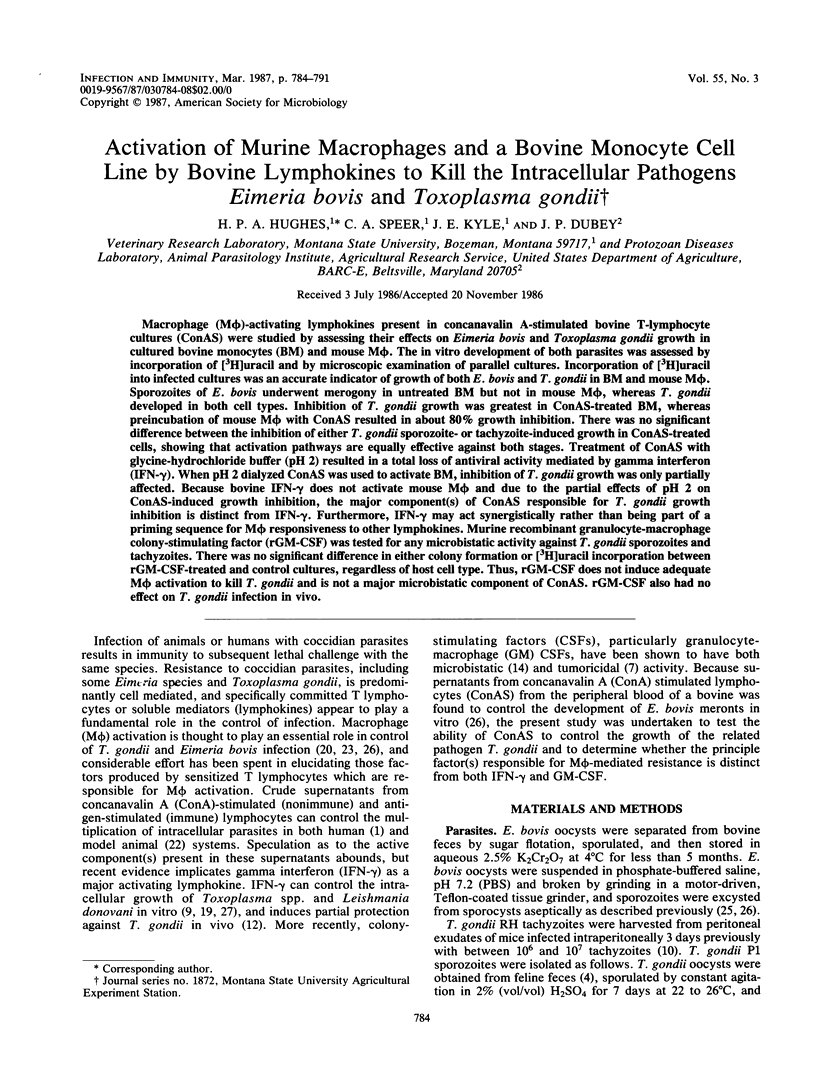
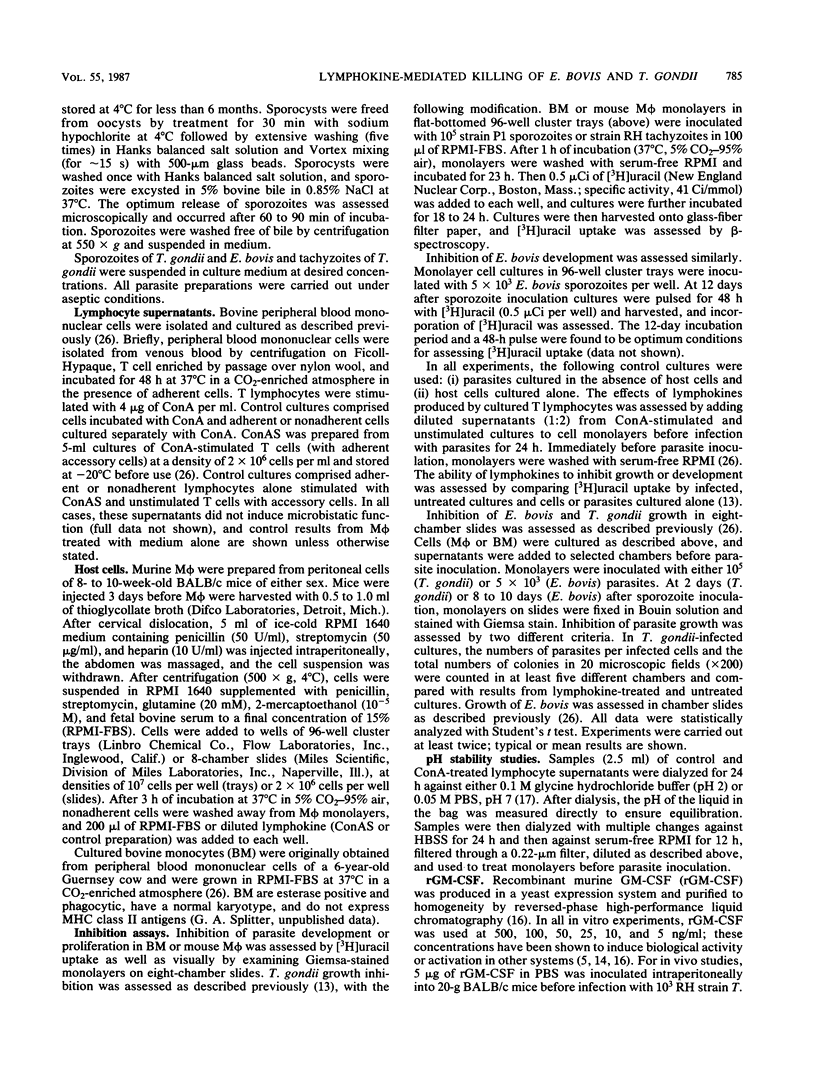
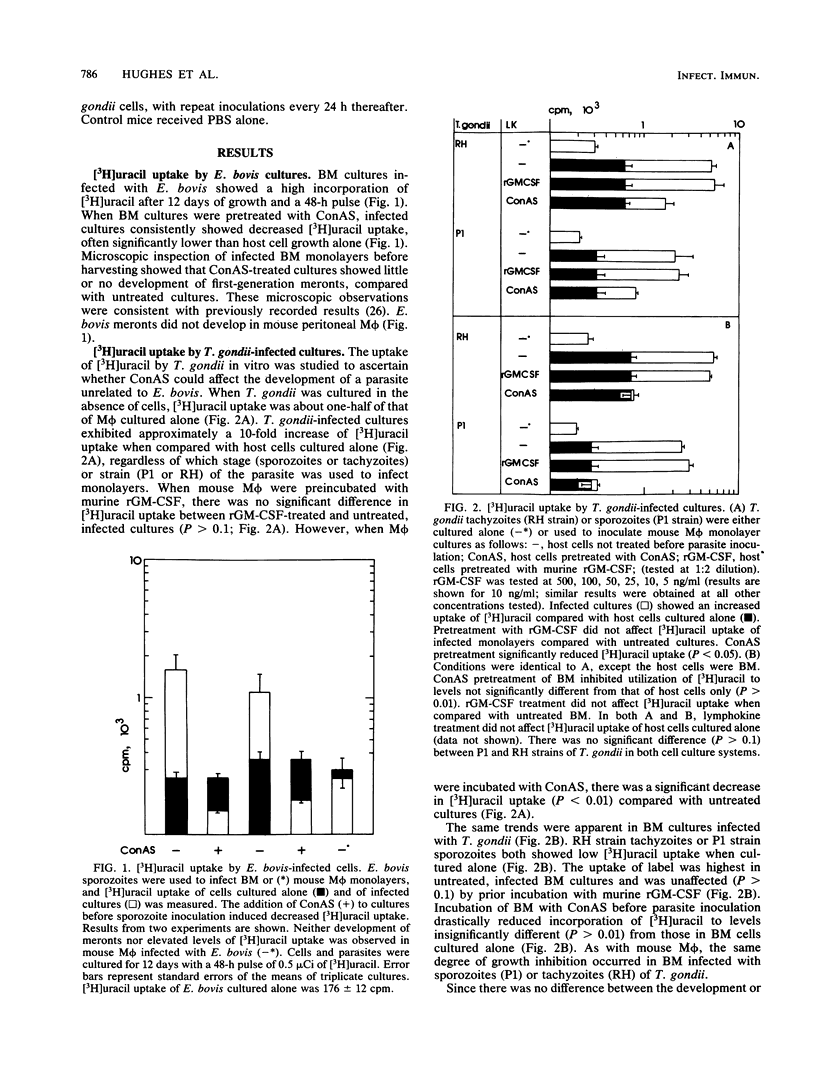
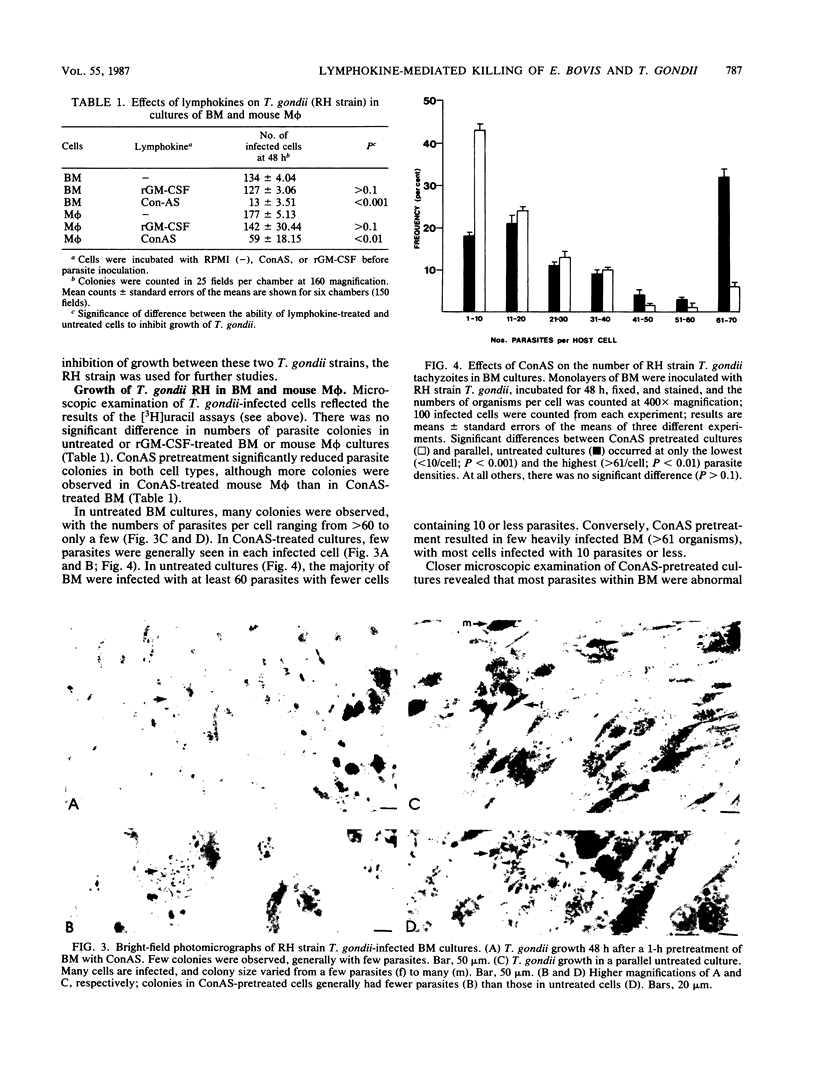
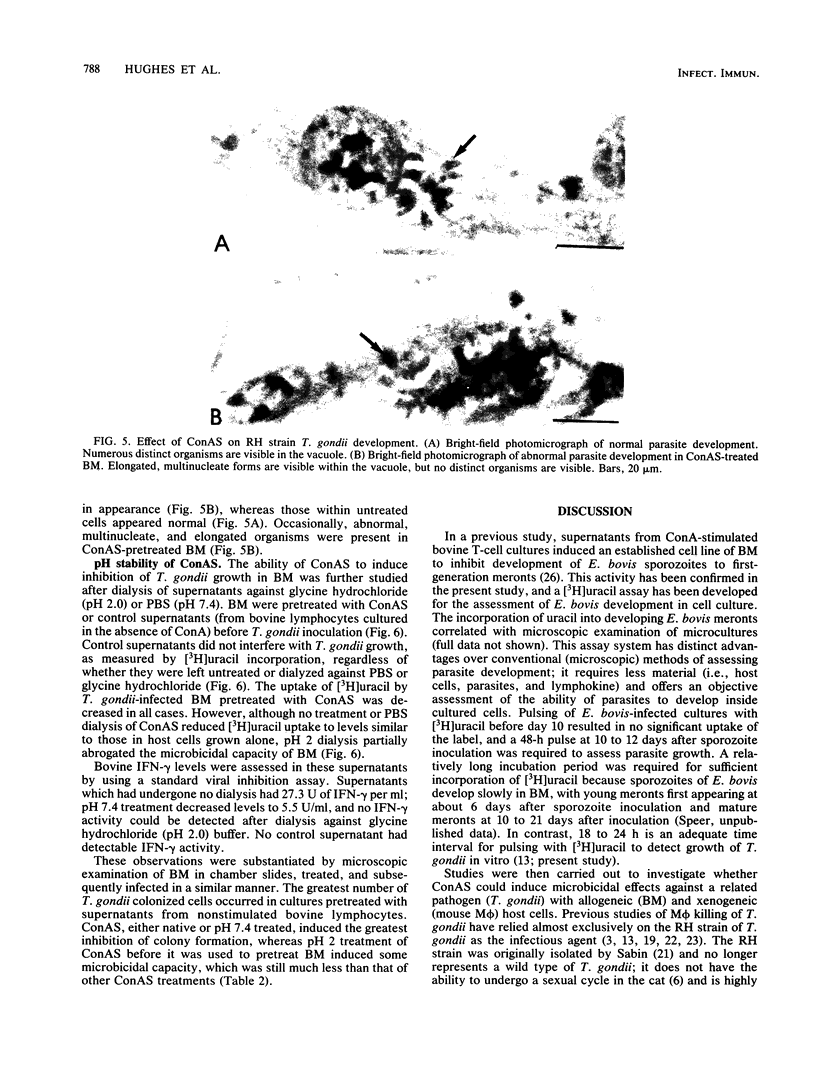
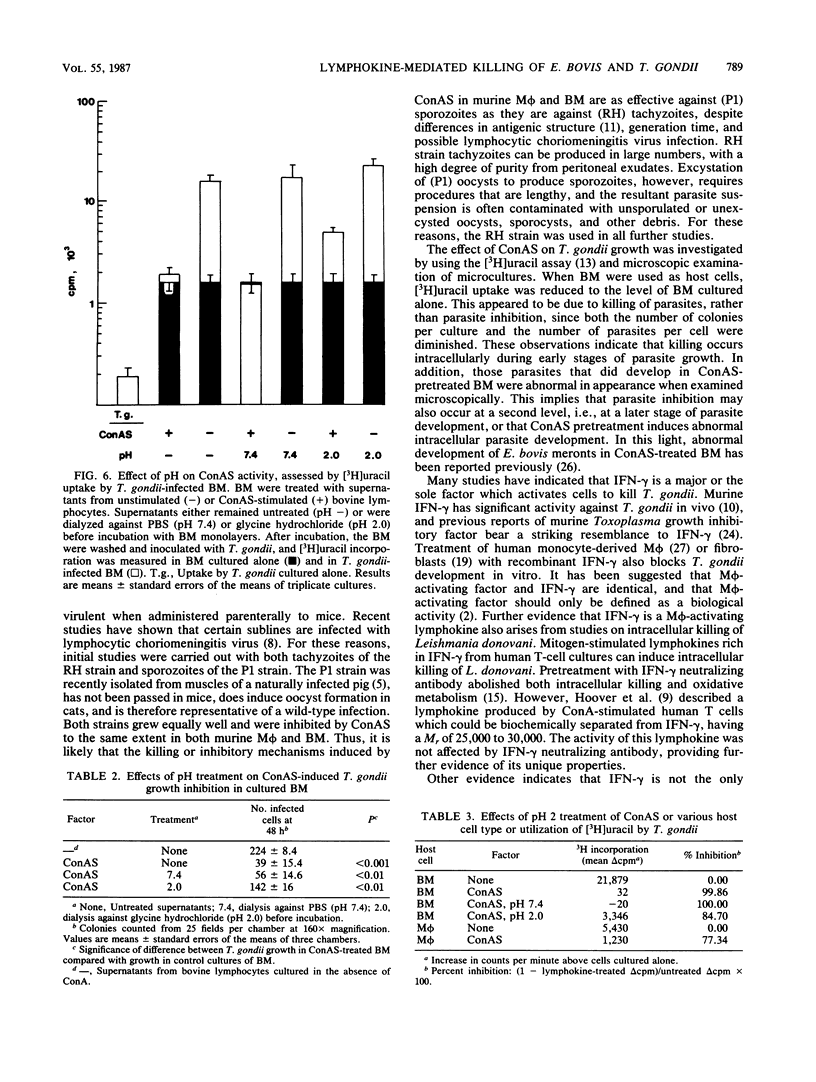
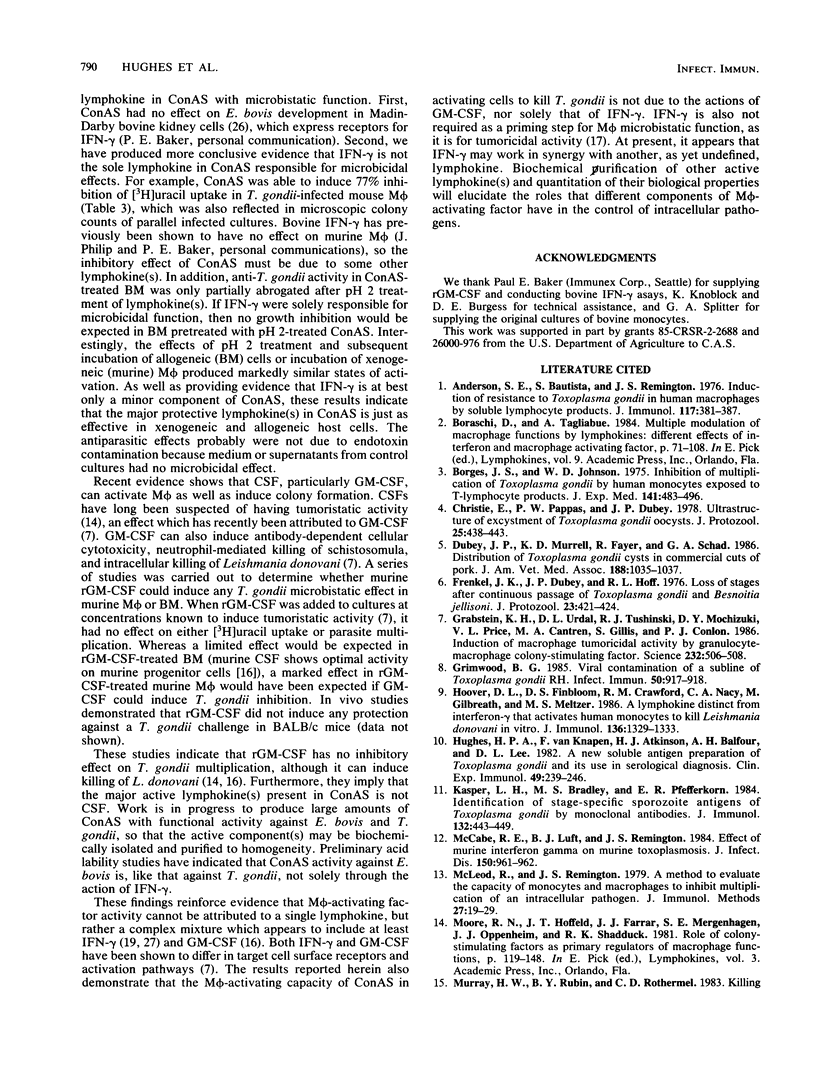
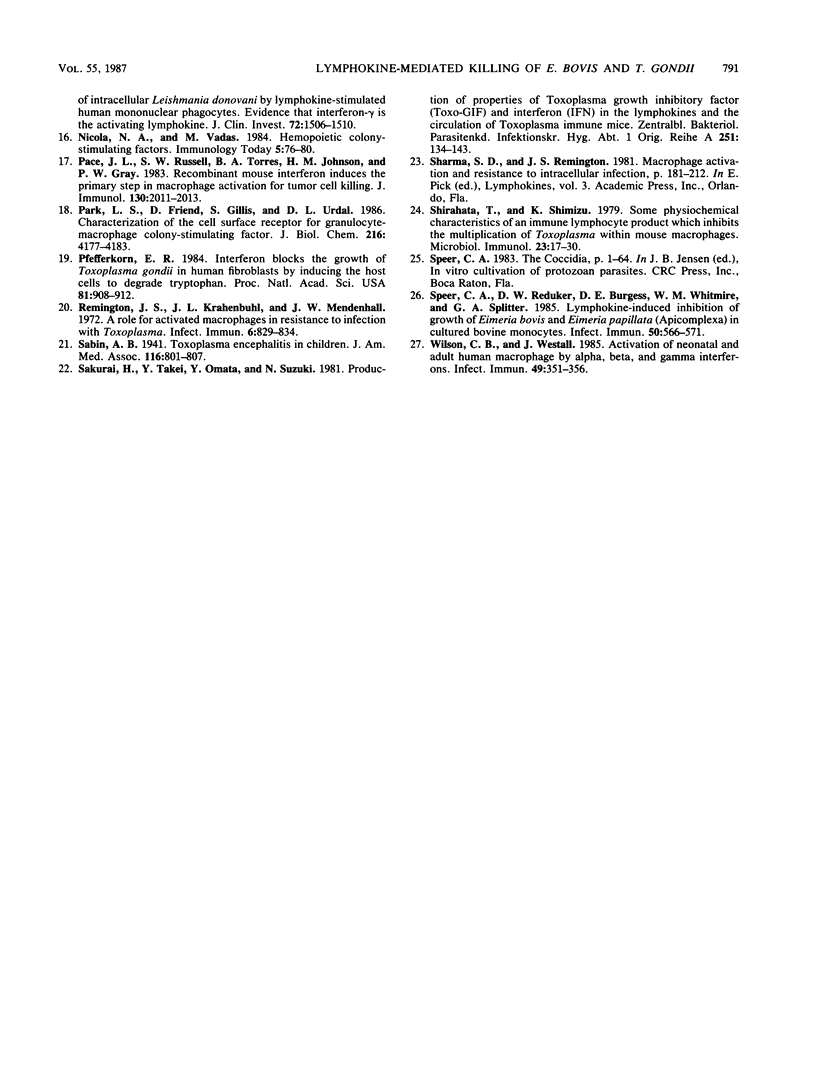
Images in this article
Selected References
These references are in PubMed. This may not be the complete list of references from this article.
- Anderson S. E., Bautista S., Remington J. S. Induction of resistance to Toxoplasma gondii in human macrophages by soluble lymphocyte products. J Immunol. 1976 Aug;117(2):381–387. [PubMed] [Google Scholar]
- Borges J. S., Johnson W. D., Jr Inhibition of multiplication of Toxoplasma gondii by human monocytes exposed to T-lymphocyte products. J Exp Med. 1975 Feb 1;141(2):483–496. doi: 10.1084/jem.141.2.483. [DOI] [PMC free article] [PubMed] [Google Scholar]
- Christie E., Pappas P. W., Dubey J. P. Ultrastructure of excystment of Toxoplasma gondii oocysts. J Protozool. 1978 Nov;25(4):438–443. doi: 10.1111/j.1550-7408.1978.tb04166.x. [DOI] [PubMed] [Google Scholar]
- Dubey J. P., Murrell K. D., Fayer R., Schad G. A. Distribution of Toxoplasma gondii tissue cysts in commercial cuts of pork. J Am Vet Med Assoc. 1986 May 1;188(9):1035–1037. [PubMed] [Google Scholar]
- Frenkel J. K., Dubey J. P., Hoff R. L. Loss of stages after continuous passage of Toxoplasma gondii and Besnoitia jellisoni. J Protozool. 1976 Aug;23(3):421–424. doi: 10.1111/j.1550-7408.1976.tb03799.x. [DOI] [PubMed] [Google Scholar]
- Grabstein K. H., Urdal D. L., Tushinski R. J., Mochizuki D. Y., Price V. L., Cantrell M. A., Gillis S., Conlon P. J. Induction of macrophage tumoricidal activity by granulocyte-macrophage colony-stimulating factor. Science. 1986 Apr 25;232(4749):506–508. doi: 10.1126/science.3083507. [DOI] [PubMed] [Google Scholar]
- Grimwood B. G. Viral contamination of a subline of Toxoplasma gondii RH. Infect Immun. 1985 Dec;50(3):917–918. doi: 10.1128/iai.50.3.917-918.1985. [DOI] [PMC free article] [PubMed] [Google Scholar]
- Hoover D. L., Finbloom D. S., Crawford R. M., Nacy C. A., Gilbreath M., Meltzer M. S. A lymphokine distinct from interferon-gamma that activates human monocytes to kill Leishmania donovani in vitro. J Immunol. 1986 Feb 15;136(4):1329–1333. [PubMed] [Google Scholar]
- Hughes H. P., Van Knapen F., Atkinson H. J., Balfour A. H., Lee D. L. A new soluble antigen preparation of Toxoplasma gondii and its use in serological diagnosis. Clin Exp Immunol. 1982 Jul;49(1):239–246. [PMC free article] [PubMed] [Google Scholar]
- Kasper L. H., Bradley M. S., Pfefferkorn E. R. Identification of stage-specific sporozoite antigens of Toxoplasma gondii by monoclonal antibodies. J Immunol. 1984 Jan;132(1):443–449. [PubMed] [Google Scholar]
- McCabe R. E., Luft B. J., Remington J. S. Effect of murine interferon gamma on murine toxoplasmosis. J Infect Dis. 1984 Dec;150(6):961–962. doi: 10.1093/infdis/150.6.961. [DOI] [PubMed] [Google Scholar]
- McLeod R., Remington J. S. A method to evaluate the capacity of monocytes and macrophages to inhibit multiplication of an intracellular pathogen. J Immunol Methods. 1979 May 10;27(1):19–29. doi: 10.1016/0022-1759(79)90235-7. [DOI] [PubMed] [Google Scholar]
- Murray H. W., Rubin B. Y., Rothermel C. D. Killing of intracellular Leishmania donovani by lymphokine-stimulated human mononuclear phagocytes. Evidence that interferon-gamma is the activating lymphokine. J Clin Invest. 1983 Oct;72(4):1506–1510. doi: 10.1172/JCI111107. [DOI] [PMC free article] [PubMed] [Google Scholar]
- Pace J. L., Russell S. W., Torres B. A., Johnson H. M., Gray P. W. Recombinant mouse gamma interferon induces the priming step in macrophage activation for tumor cell killing. J Immunol. 1983 May;130(5):2011–2013. [PubMed] [Google Scholar]
- Park L. S., Friend D., Gillis S., Urdal D. L. Characterization of the cell surface receptor for granulocyte-macrophage colony-stimulating factor. J Biol Chem. 1986 Mar 25;261(9):4177–4183. [PubMed] [Google Scholar]
- Pfefferkorn E. R. Interferon gamma blocks the growth of Toxoplasma gondii in human fibroblasts by inducing the host cells to degrade tryptophan. Proc Natl Acad Sci U S A. 1984 Feb;81(3):908–912. doi: 10.1073/pnas.81.3.908. [DOI] [PMC free article] [PubMed] [Google Scholar]
- Remington J. S., Krahenbuhl J. L., Mendenhall J. W. A role for activated macrophages in resistance to infection with Toxoplasma. Infect Immun. 1972 Nov;6(5):829–834. doi: 10.1128/iai.6.5.829-834.1972. [DOI] [PMC free article] [PubMed] [Google Scholar]
- Sakurai H., Takei Y., Omata Y., Suzuki N. Production and properties of Toxoplasma growth inhibitory factor (Toxo-GIF) and interferon (IFN) in the lymphokines and the circulation of Toxoplasma immune mice. Zentralbl Bakteriol Mikrobiol Hyg A. 1981 Dec;251(1):134–143. [PubMed] [Google Scholar]
- Shirahata T., Shimizu K. Some physicochemical characteristics of an immune lymphocyte product which inhibits the multiplication of toxoplasma within mouse macrophages. Microbiol Immunol. 1979;23(1):17–30. doi: 10.1111/j.1348-0421.1979.tb00436.x. [DOI] [PubMed] [Google Scholar]
- Speer C. A., Reduker D. W., Burgess D. E., Whitmire W. M., Splitter G. A. Lymphokine-induced inhibition of growth of Eimeria bovis and Eimeria papillata (Apicomplexa) in cultured bovine monocytes. Infect Immun. 1985 Nov;50(2):566–571. doi: 10.1128/iai.50.2.566-571.1985. [DOI] [PMC free article] [PubMed] [Google Scholar]
- Wilson C. B., Westall J. Activation of neonatal and adult human macrophages by alpha, beta, and gamma interferons. Infect Immun. 1985 Aug;49(2):351–356. doi: 10.1128/iai.49.2.351-356.1985. [DOI] [PMC free article] [PubMed] [Google Scholar]




